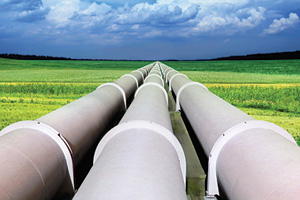
|
| Photo credit: ©istockphoto.com/ssuaphoto |
As statistics from McGraw-Hill Construction and other reputable national construction analysts come filtering in, with last year’s results and upcoming forecasts, it’s becoming increasingly apparent the residential sector is in a strong comeback mode. At the same time nonresidential and nonbuilding aspects are mediocre and depressing, respectively. As 2014 evolves from its early startup level, we envision the disparate construction sectors developing accordingly.
- Residential. This once-explosive backbone of U.S. construction surprised with a formidable 2013 comeback in both a single-family and multifamily housing rebound. Although the inventory of unsold housing is shrinking, with foreclosures down, and demand and pricing up, more than half of housing units are shifting toward rental or long-term leasing. With overseas investment an additional factor, expect 2014 to be expanding the housing comeback.
- Nonresidential. This gamut of offices, retail, hotels, warehouses, educational institutions, health-care, recreational and government buildings comprising this subsector of last year’s generally flat volume will likely project only moderate improvement from last year’s mediocre performance. While health-care expansion may lead the pack, online retail may bite deeply into strip malls, department stores and shopping centers. Little improvement should be expected.
- Infrastructure. What could prove the big upward spiral is the long-awaited and deliberate postponement of highways, bridges, dams and reservoirs, river and harbor developments, sewage and wastewater supply systems, missile and space facilities, power utilities and communications systems.
But even more dramatic could be the infrastructure of oil and gas pipelines plus the almost deliberate negligence that has befallen our nation’s electrical systems. Delayed in the wake of the millennial year beginning, brought on by the Enron scandal distortion of electric energy excess, manifested later by the Texas company’s malevolent misguidance, makes the need for urgent upgrading imperative to forestall brownouts and blackouts.
Only the cutback in electrical usage in the past year, due to the continuity of the commercial/industrial recession, has prevented this federal indifference from becoming the genesis of a nationwide shortage, bordering on calamity.
With conversion from coal to natural gas and too much dependence on government-subsidized renewables, major weather disruptions later in the year could still cause serious problems if no steps are taken now to remedy the situation and put extreme regulations on hold.
Unfortunately, little is coming out of Washington, D.C., to indicate urgency. Only if the private sector takes the “bull by the horns” with pipeline and electric utility upgrading will both a construction boom and consumer demand satisfaction remedy a deteriorating situation.
Budget deficit shrinkage
U.S. official verification of a 37.5% budget deficit drop in fiscal year 2014’s first four months (Oct.-Jan.) would indicate an annual budget deficit of $350 billion, the lowest level in eight years. This positive evolution comes on the tail of a major drop in the 2013 budget deficit after four fiscal years, well in excess of one trillion dollars. This has increased the U.S. Treasury debt from $10 trillion plus, at the time of President Barack Obama’s inauguration, to the current $17 trillion, even if at a slower pace of increase.
In examining the major factors slowing down the national debt and reducing the annual deficit, the following four factors stand out:
- Tax increases. In addition to raising the highest bracket from 35% to 39.6%, a number of stealth taxes, ostensibly to pay for increasing Medicare costs, were added in 2013, with an additional 0.9% this year. In addition, taxes on dividend income, which had been reduced from invested ordinary income (35% at highest bracket) to 15% during the President George W. Bush era, have been increased to 20%, with an additional 3.8% add-on forthcoming during calendar 2014 for the top bracket.
- Defense Department reductions. America’s active-duty fighting forces are drawing down to the lowest level since the 9/11/01 outrage, pulling out of both Iraq and Afghanistan, plus cancelling the upgrading of Army, Navy and Air Force equipment, while the Marine Corps is now at its lowest level since World War II.
- Slowdown in government agency increases. Although the size and quantity of government agencies has far surpassed the numbers and expenditures that existed in previous administrations, a definitive slowdown has occurred in the scope of increase. While reductions are few and far between, there are increasing indications of not replacing retirees.
- Shale oil and natural gas development. What is likely to be a major plus for stabilizing the debt and decreasing the deficit is the accelerating revenues being generated by the unprecedented massive development of shale oil and natural gas. Other aspects of energy development, such as oil/natural gas and electrical power distributed through piping infrastructure development should add substantial pluses to the U.S. Treasury’s coffers.
What will further add to America’s credit-worthiness is the near doubling of the United States’ natural resource discoveries, especially through the fracking process of oil and natural gas, plus liquid natural gas exports and refined crude oil derivatives, such as gasoline and diesel fuel, jet fuel, heating oil and varied end-use products.
It has been estimated by reliable sources that America’s household wealth of $90 trillion has been supplemented by a similar monetary volume through natural resource expansion. This alone greatly diminishes the negative effect of the humongous U.S. debt as a percentage of America’s total value, a point that will not be lost on the various global credit-rating agencies.
Fed faces quandary
With the advent of Janet Yellen as chair of the Federal Reserve Board at the crucial point of a U.S. economy ready to spring forward with the cloud of unemployment still hanging over its head, new rumblings of a change are coming by the Federal Reserve Board’s potential Fed funds interest rate increase.
Although any upward move in the Fed funds rate will not be forthcoming until 2015, the “tapering” from a previous multimonth high of $85 billion in monthly purchases of U.S. Treasury paper and mortgage-backed derivatives from major banks, will likely ease periodically throughout 2014.
With the Labor Department’s official unemployment rate of 6.7%, the Fed’s previous commitment of restraining its Fed funds rate increase when unemployment hits a 6.5% bottom may face the Central Bank sooner than expected. However, the reality that the traditional Labor Department rate is totally unrelated to the labor participation index actuality will likely tend to restrain an interest rate forward move until next year.
Although Chairman Yellen’s policies tend to duplicate ex-chairman Ben Bernanke’s “bearish” economic stance, the expected 2014 gross domestic product growth factor will likely force the Fed to bring down its quantitative easing policy with regularity throughout the year. The Fed’s slackening of Treasury bond purchases, as the single most voluminous buyer, will, in itself lower the prices of the week’s Treasury auctions and increase their yield.
This will pressure commercial interest rates to slowly move up as the year progresses, despite the Federal Reserve Board’s position of restraint. Such commercial interest rate increases will anticipate an expectant economic expansion.
With the Federal Reserve Board caught in a vise of its own making by focusing on unemployment as a major factor for its Fed funds increase from the effective “zero” position taken three years ago, the new Fed chair will have to provide a balanced direction going forward. It is likely she will be faced with an increasingly muscular 2014 economy, continuing multiyear low inflation and creeping commercial interest rates as competition for bank loans, as well as the more aggressive use of hundreds of billions of dollars reposing on corporate balance sheets manifesting themselves.




